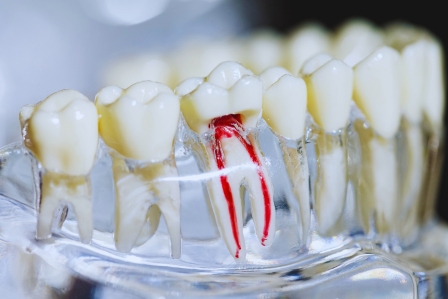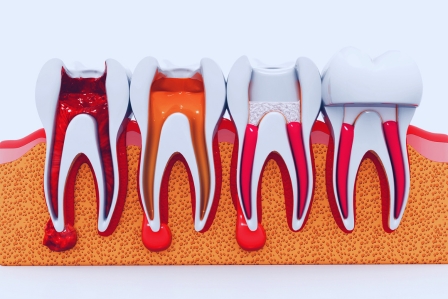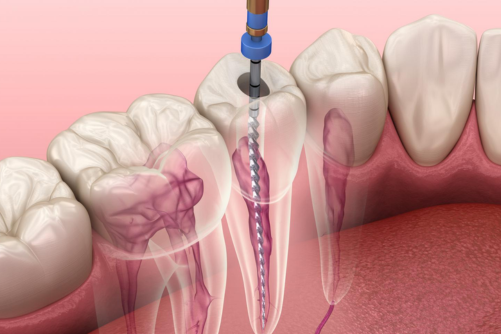
Root canal treatment is one of the most common dental procedures to save a damaged or infected tooth.
This is a highly effective procedure. However, sometimes, it can fail. This can lead to discomfort and complications.
Spotting root canal failure early can help prevent severe pain and unnecessary procedures. In this blog, we’ll guide you through the signs of failure and what steps you should take to address the issue.
What Can Cause Root Canal Failure?
There are several reasons why a root canal might fail despite treatment:
Incomplete Cleaning of the Root Canal
Sometimes, all the infected tissue inside the root canal isn’t completely cleaned out, leading to an ongoing infection. This can occur if the canal system is too complex for the dentist to access or clean fully.
Re-infection
Even after a successful root canal, the tooth may become re-infected if bacteria enter through cracks or poor sealing. Without a proper seal, the tooth is vulnerable to re-infection.
Missed or Complex Root Canals
Teeth can have multiple canals or unusual shapes that make cleaning and sealing more difficult. In some cases, dentists may miss a smaller canal or a hidden infection that can lead to failure.
Fractured Tooth or Root
A fracture in the tooth or root can make it impossible for the root canal treatment to be effective. Cracks or fractures allow bacteria to enter, causing infection even after the canal has been treated.
What are the Signs of Root Canal Failure?
When a root canal doesn’t heal as expected, certain signs may indicate a problem. Pay attention to the following:
Persistent Pain
After a root canal, some discomfort is normal, but it should gradually fade. Persistent pain or discomfort in the treated tooth is a red flag. If the pain lingers for weeks or months, or if it worsens over time, it could mean the treatment didn’t fully resolve the issue. This could be due to an infection that wasn’t entirely removed or a crack in the tooth that wasn’t detected.
Swelling and Tenderness
Swelling around the treated tooth, especially in the gums, may indicate an ongoing infection. The area may also feel tender to the touch. If you notice swelling, it’s important to see your dentist right away, as untreated infections can spread to other areas.
Discoloration of the Tooth
A tooth that darkens or becomes discolored after a root canal can signal that the treatment didn’t fully address the underlying problem. Discoloration often results from a lack of blood supply to the tooth after the procedure, which may point to an infection or other complications.
Sensitivity to Temperature
Root canal treatment aims to eliminate sensitivity, but some patients may experience renewed sensitivity to hot or cold. If you feel sharp pain or discomfort when drinking hot or cold beverages, it may suggest that the tooth is still infected or that there is damage to the filling.
Bump or Pimple on the Gums
Sometimes, a small bump or pimple-like lesion appears near the treated tooth. This could be an abscess caused by an infection in the root or surrounding tissues. If the bump drains pus or fluid, it’s a sign that the infection hasn’t fully healed and requires attention.
What to Do if You Suspect Root Canal Failure?
If you experience any of the signs after getting a root canal in Moundridge, KS, it’s essential to take action quickly.
Here are the steps you should follow:
See Your Dentist
Contact your dentist as soon as possible if you suspect root canal failure. They will likely take an X-ray to assess the tooth and check for infection or other issues. A proper diagnosis is crucial before taking further steps.
Retreatment or Re-root Canal
In some cases, your dentist may recommend retreating the root canal. This involves reopening the tooth, cleaning it again, and resealing it. Retreatment can be an effective way to remove persistent infection and give the tooth a second chance.
Apicoectomy
If retreatment isn’t an option or the infection persists, an apicoectomy may be necessary. This procedure involves removing the tip of the tooth’s root along with any infected tissue. After the procedure, the tooth may be sealed to prevent further infection.
Tooth Extraction
In rare cases, if a root canal treatment fails and the tooth can’t be saved, extraction may be the only option. The dentist will remove the damaged tooth, and you can discuss options for replacing it, such as implants or bridges.
How to Avoid Root Canal Failure?
While not all cases of root canal failure can be prevented, there are steps you can take to lower the chances:
Maintain Good Oral Hygiene
Brushing and flossing regularly are essential to keep your teeth and gums healthy. Good oral hygiene can help prevent infections and tooth decay, which can compromise the success of a root canal.
Regular Dental Checkups
Visiting your dentist regularly for checkups and cleanings helps catch potential problems early. They can detect signs of root canal failure, such as infection or damage, before they worsen.
Avoid Chewing on Hard Objects
To prevent fractures or cracks in the tooth, avoid chewing on hard objects like ice, pens, or hard candies. These can damage the tooth or root and lead to complications after a root canal.
Protect Your Teeth
If you grind your teeth, especially at night, consider using a mouthguard to protect your teeth from damage. Bruxism can cause cracks in teeth, making them more susceptible to root canal failure.
Root canal failure can be frustrating, but it’s possible to address the issue effectively with the right care. You can avoid serious complications by recognizing the signs early and seeking prompt treatment. If you suspect a failed root canal, reach out to your dentist to explore your options. With proper care, you can maintain a healthy smile for years to come.
Taking action early can help protect your oral health and reduce the risk of further complications, so don’t hesitate to schedule an appointment if you notice any concerning symptoms.


